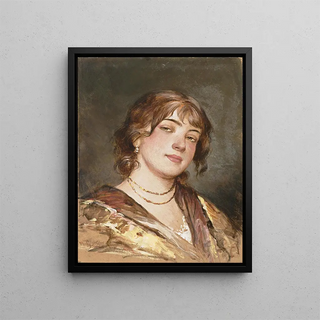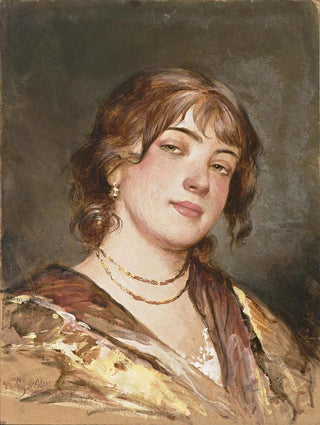Art print | Portrait of an Italian young woman - Eugen von Blaas


View from behind

Frame (optional)
Portrait of an Italian Young Woman - Eugen von Blaas – Captivating Introduction
In the vibrant world of art, some works manage to capture the very essence of their era while transcending time. The "Portrait of an Italian Young Woman" by Eugen von Blaas is one of those. This piece, imbued with delicacy and sensitivity, invites the viewer to immerse themselves in a universe where beauty and emotion intertwine. The depiction of a young woman, both mysterious and alluring, evokes a spectrum of feelings that resonate deeply with anyone who gazes upon it. Through its timeless grace, this painting embodies a dialogue between the artist and her model—a silent conversation that intrigues and captivates.
Style and uniqueness of the work
Eugen von Blaas's style is distinguished by his ability to blend realism with a touch of idealism. In this portrait, the young woman is portrayed with remarkable precision, every detail of her face and attire carefully crafted. The interplay of light and shadow creates an intimate atmosphere, while the colors, both soft and vibrant, breathe life into the canvas. The blurred background emphasizes the presence of the model, as if the outside world fades away to leave room for the depth of her gaze. This stylistic choice demonstrates exceptional craftsmanship, allowing the work to align with the tradition of great masters while asserting a distinct identity.
The artist and his influence
Eugen von Blaas, born in 1843 in Venice, was an artist whose career was marked by an unwavering passion for painting. Trained in the ateliers of the great masters of his time, he developed a style that is uniquely his own, drawing inspiration from the artistic currents of his era while adding his personal touch. His work often bears a certain nostalgia—a quest for the feminine ideal that echoes in his portraits. Von Blaas was able to capture not only the physical beauty of his models but also psychological depth, making each portrait unique. His influence extends beyond his own production, inspiring many artists who seek to explore themes of femininity and

Matte finish

View from behind

Frame (optional)
Portrait of an Italian Young Woman - Eugen von Blaas – Captivating Introduction
In the vibrant world of art, some works manage to capture the very essence of their era while transcending time. The "Portrait of an Italian Young Woman" by Eugen von Blaas is one of those. This piece, imbued with delicacy and sensitivity, invites the viewer to immerse themselves in a universe where beauty and emotion intertwine. The depiction of a young woman, both mysterious and alluring, evokes a spectrum of feelings that resonate deeply with anyone who gazes upon it. Through its timeless grace, this painting embodies a dialogue between the artist and her model—a silent conversation that intrigues and captivates.
Style and uniqueness of the work
Eugen von Blaas's style is distinguished by his ability to blend realism with a touch of idealism. In this portrait, the young woman is portrayed with remarkable precision, every detail of her face and attire carefully crafted. The interplay of light and shadow creates an intimate atmosphere, while the colors, both soft and vibrant, breathe life into the canvas. The blurred background emphasizes the presence of the model, as if the outside world fades away to leave room for the depth of her gaze. This stylistic choice demonstrates exceptional craftsmanship, allowing the work to align with the tradition of great masters while asserting a distinct identity.
The artist and his influence
Eugen von Blaas, born in 1843 in Venice, was an artist whose career was marked by an unwavering passion for painting. Trained in the ateliers of the great masters of his time, he developed a style that is uniquely his own, drawing inspiration from the artistic currents of his era while adding his personal touch. His work often bears a certain nostalgia—a quest for the feminine ideal that echoes in his portraits. Von Blaas was able to capture not only the physical beauty of his models but also psychological depth, making each portrait unique. His influence extends beyond his own production, inspiring many artists who seek to explore themes of femininity and






